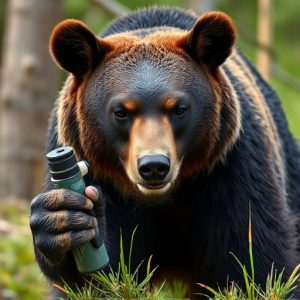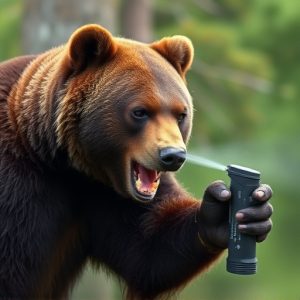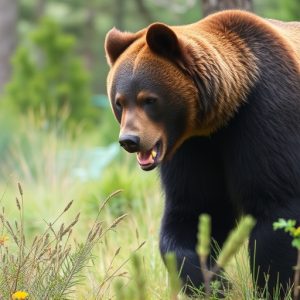Mastering Alaska’s Bear Spray Fog Pattern: Effectiveness & Best Practices
Bear spray, with its specialized fog pattern and higher capsaicin concentrations, is more effective…….
Bear spray, with its specialized fog pattern and higher capsaicin concentrations, is more effective than regular pepper spray against aggressive bears. Its design discourages bear attacks over a broader area due to its range and power, making it the preferred choice for outdoor enthusiasts in bear country. While pepper spray causes temporary blindness, bear spray disrupts a bear's sense of smell, offering better protection during wildlife encounters. Choosing the right self-defense option involves understanding these key differences, especially regarding "Is Bear Spray Stronger Than Pepper?" Proper usage and preparation are crucial for safety during bear encounters in Alaska or other regions with high bear activity.
“In the rugged landscapes of Alaska, understanding bear spray fog patterns is vital for hikers and outdoor enthusiasts. This guide delves into the science behind bear spray effectiveness, comparing it to pepper spray, and exploring factors influencing its range and power.
From ‘Understanding Bear Spray Fog Patterns’ to ‘Best Practices for Using Bear Spray in Alaska’, learn how to navigate this potential life-saver. Discover why knowing the difference between is bear spray stronger than pepper spray can be a matter of safety and survival.”
- Understanding Bear Spray Fog Patterns
- The Science Behind Bear Spray Effectiveness
- Comparing Pepper Spray to Bear Spray
- Factors Influencing Bear Spray Range and Power
- Best Practices for Using Bear Spray in Alaska
Understanding Bear Spray Fog Patterns
Understanding Bear Spray Fog Patterns is key to maximizing its effectiveness in potentially dangerous encounters. The fog pattern refers to how the spray disperses and creates a protective barrier between you and the bear. Unlike direct-stream or liquid sprays, bear spray creates a thick, lingering mist that can cover a larger area, making it ideal for unpredictable wildlife interactions. This unique delivery system allows the spray to reach bears from various distances and angles.
When considering whether bear spray is stronger than pepper spray, it’s essential to note their distinct differences. Bear spray typically contains capsaicin, similar to pepper spray, but in higher concentrations tailored for larger animals like bears. While pepper spray may cause temporary blindness and respiratory distress at close range, bear spray is designed to create a barrier that discourages aggressive behavior from bears over a broader area. The fog pattern ensures a more even distribution of the active ingredient, making it a powerful tool for self-defense in bear country.
The Science Behind Bear Spray Effectiveness
The effectiveness of bear spray, also known as pepper spray specifically designed for wildlife, lies in its unique fog pattern and active ingredients. Unlike traditional pepper spray used for self-defense against humans, which typically creates a direct spray, bear spray is engineered to disperse quickly and form a dense cloud or fog. This fog pattern allows for maximum coverage, ensuring that bears inhaling the spray come into contact with capsaicin, the active ingredient responsible for its potent effects.
When comparing bear spray to regular pepper spray, the former often proves more effective due to its specialized design. The stronger concentration of capsaicin in bear spray and the fog pattern’s ability to envelop both front and back make it a more reliable deterrent against aggressive bears. This is especially true when considering that bears have an excellent sense of smell, making direct contact with a spray more challenging than with other pepper sprays.
Comparing Pepper Spray to Bear Spray
When considering self-defense options in Alaska’s wild, it’s crucial to understand the differences between pepper spray and bear spray. While both are designed to incapacitate an attacker, their chemical compositions and intended targets vary significantly. Pepper spray, a common choice for personal defense, uses capsaicin to cause temporary blindness and respiratory distress. It’s effective against humans but less reliable against bears due to its shorter range and the animal’s thick fur and skin.
Bear spray, specifically designed for use against bears, typically contains a higher concentration of capsaicin and other chemicals like oleoresin capsicum (OC). This combination creates a dense fog with a much longer reach, allowing it to cover both the eyes and nasal passages of an attacking bear. Studies suggest that bear spray is generally more effective than pepper spray when facing aggressive bear encounters, making it the preferred choice for outdoor enthusiasts and residents in bear country.
Factors Influencing Bear Spray Range and Power
The effectiveness of bear spray, or more specifically, its range and power, is influenced by a multitude of factors. One key aspect is the environmental condition during the spray deployment; wind speed and direction can significantly impact the reach and intensity of the fog pattern. A light breeze might carry the spray further, but a strong gust could dissipate it quickly. Topography also plays a role; in areas with steep slopes or uneven terrain, the spray’s path may be altered, affecting its coverage.
Another crucial element is the specific type of bear spray and its composition. Unlike pepper spray designed for human self-defense, which primarily irritates the eyes and respiratory system, bear spray is formulated to deter bears by targeting their sense of smell. This means that bear spray might not be as potent in terms of burning or stinging sensation but can still create a powerful enough fog to disrupt and disorient a bear. The concentration of capsaicin (the active ingredient) and the distance it travels determine whether the spray is more effective than pepper spray in specific scenarios, especially when considering the larger range and fog pattern of bear spray designed for outdoor adventures and wildlife encounters.
Best Practices for Using Bear Spray in Alaska
In Alaska, where encounters with bears are a real possibility, understanding how to use bear spray effectively is crucial for your safety. When faced with an aggressive bear, using bear spray can create a barrier between you and the bear, giving you time to retreat or seek shelter. It’s important to remember that not all bear sprays are created equal; in particular, comparing the strength of bear spray to pepper spray isn’t entirely accurate as they serve different purposes. Bear spray is designed to deter bears specifically by disrupting their sense of smell, while pepper spray targets human attackers.
When using bear spray in Alaska, follow these best practices: ensure the can is properly registered and legal in the state, practice your spray technique beforehand, and always keep it within reach when hiking or camping. Remember, the ideal time to use bear spray is when a brown or black bear shows signs of aggression or approaches you. Aim for the bear’s face and eyes from a safe distance, as this will reduce the risk of inhalation for you while maximizing the impact on the bear.
In conclusion, understanding the unique fog pattern of bear spray is key to ensuring its effectiveness during encounters in Alaska’s diverse landscapes. The science behind its action reveals a powerful tool against bears, even surpassing pepper spray in terms of potency and range. By knowing the factors influencing its performance and following best practices, individuals can enhance their safety while exploring these pristine wilderness areas. Armed with this knowledge, visitors can navigate through Alaska’s beauty with confidence and peace of mind.


